Robert Knox's Blog, page 36
October 12, 2016
The Garden of the Trees: A Berkshires Weekend: Fall fab weekend
Here's a photo of the Stone Seat, that was the favorite woodland walk destination for a Williamstown figure.... I know nothing of Williamstown really, except for the Clarke Art Museum. Turns out there's a series of walking paths in the woods and pasture land behind the museum. Our trail gude calls the site "Williamstown's favorite walk." The most popular destination is the xxx Stone Bench favored over a century ago by George Mortitz wahl, German-born, retired professor who walks to his favorite spot in the woods and died in 1923. They built a stone bench at intersection of the trails. We walked some of these trails, where you stop seeing people According to Williams College Record, the college newspapert, There are numerous trails on the hill that can be combined for hikes ranging from 0.7 to 4.0 miles in length. When hiked clockwise, the approximately 4-mile path described here provides the hiker with dense forests, massive rock outcroppings and, at the very end," a great view of tpwm f Williamstown and the Green Moutns opf Vr=ermont. Which I don't thknk we knew about because we certainly didn't find it. We did find crowded paring olots in the retail streets around the Williams College, one of the few crwods on an otherwise highy subdued three-day October weekend in the Berkshires. Little traffic to speak of on Route 7, a road we've been locked up on, other Columbus Day weekends. Maybe everybody else kne was the weather was gong to clouds the first day followed by rain the second. The third day, the day when we had to leave, was in true Berkshire fashion crystal clear and absolutely stunning. Our next site, after the crowded intown parking lot, where we looked for essential provisions (coffee), was one of the best autumn day picnic spots we'ver ever found. It was right on the farmyard of the Sheep Hill farm (something preserve). A picnic table surrouned by the steep pasture on one side and the view of thickly wooded hills across Rpute 7 rising up to Mount Greylock, the highest point in the state. We had the place completely to ourselves. No one else around. his 50-acre former dairy farm was purchased by the Williamstown Rural Lands Foundation in 2000. Art and Ella Rosenburg and their son ‘young Art’ moved here in 1933 and had a milking herd for more than 50 years.e Williamstown Rural Lands Foundation (http://wrlf.org/sheep-hill/) It was called Sunny Brook Farm, and the landscape Sheep Hill, for the sheep raised here in the late 19th century. I took some photos of the strikingly furrowed tractor-cut patterns of the hayed meadow. The contours are more prominent and the gradient steeper than what the camera captures. Ffrom the path along the top of the pasture I took photos of the foliage on the ridges, and one of the observation tower on top of Greylock.
Published on October 12, 2016 20:45
October 6, 2016
Under the Shadow of History: Four Dates for "Suosso's Lane" Before the Election
Given the prominence of terrorist attacks, political unrest both internationally in the US, and the election season targeting of immigrant groups, 2016 is growing remarkably similar to the year 1920 when Nicola Sacco and Plymouth resident Bartolomeo Vanzetti were arrested in a climate of violence and political repression. I have some program dates to present "Suosso's Lane," a novel based on the scandalously unjust trial and execution of Sacco and Vanzetti for a murder most people believe they did not commit, in the next few weeks.
I'm taking part in a new book program at Milton Public Library on Sunday, Oct. 16, called “Fall Into Reading: Meet Local Authors.” The authors will have an opportunity to introduce themselves and their book to the public. And each of us will have a table on which to set up our books, meet with potential readers, offer books for sale, sign them, or just hang around. The event takes place from 2 to 4 p.m.; the library is located at 476 Canton Ave., Milton. The next evening, Monday, Oct. 17, I will be speaking on "Suosso's Lane," my novel on the Plymouth, Mass. origins fo the famous Sacco-Vanzetti case, at The James Library and Center for the Arts, 24 West St., Norwell, Mass. The time is 7 p.m.; it's free. Later in the month I'll continue my rounds of Plymouth Country libraries with a program on "Suosso's Lane" at the West Bridgewater Library, 80 Howard St., on Thursday, Oct. 27, at 2 p.m.
Finally, one more date, before the election, on Wednesday, Nov. 2, at 7 p.m., I will be speaking on the book at Pilgrim Hall, the nation's first public museum, at 75 Court St., Plymouth. I hope to see some friendly faces somewhere along the line
With the Presidential election less than two weeks away on that day, I hope to be able to draw some attention to the lessons of the Sacco-Vanzetti by pointing out some similarities in today's politics to those of the 1920s when Sacco and Vanzetti were convicted of murder largely because of the unpopular beliefs and their nationality. For "Italians" in the first decades of the 20th century, substitute "Mexicans" or "Muslims" and you'll get the picture.
The historical events dramatized in “Susosso's Lane,” while they took place a long time ago, raise questions that are still with us. Do we learn from the past? Can we? Perhaps it helps to remember what happened long ago in 1920's America.
Among the social, political and economic isses that wre important then and are equally important now was the stark and ugly disparity between the very and the masses of the poor, including those who worked long hours in low-paying, exploited labor. In "Suosso's Lane," I have titled an early chapter "America Taught Him Who He Was."
Though he had begun to think for himself in Italy, and had been worked nedarly to death in pastry factories in Italian cities, Vartolomeo Was not an anarchist when he reached the shores of the "new world" in 1908. By the time he trudged in Plymouth in 1913, his experience of life in this country, at the bottom of the heap where thousands and thousands of immigrants, as well as native-born Americans, struggled to survive, the still young Vanzetti had committed himself to the cause. These experiences, Vanzetti reflects in "Suosso's Lane," "taught him who he was, even before any of all the other things he was: a man, an Italian, an immigrant, a pastry chef, a reading man, a kind man, even a son. He was an anarchist."
But being that thing that was regarded as a threat,an evil, by a frightened socity in a time of social and politrical stresses, could prove a danger. Especially when combined with another starnd of identity also abhorred by the 1920s American mainstream: an Italian.
"I am suffering," Vanzetti told a court in Dedham, Mass., after being condemned to death, "because I am a radical, and because I am an Italian."
athe great majority of the
The
Here's The James Library's PR on the date:
“Suosso's Lane” is based on the scandalously unjust trial and execution of Sacco and Vanzetti for a murder most people believe they did not commit, the international cause-celebre of the 1920’s. The novel follows the search for evidence of Vanzetti’s innocence lost for decades to a government sanctioned frame-up. Historical events recounted in
the international cause-celebre of the 1920’s.
program dates coming up this month.
Published on October 06, 2016 20:50
October 3, 2016
The Garden of Verse: Poems in October's Verse-Virtual Shine Like October Skies
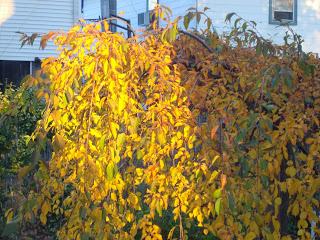 The October edition of Verse-Virtual offers some ravishing poems for a ravishing month. The passion play of the seasons reaches a kind of climax in October, given the sensational blossom/dying fall of the northern woods and the "urban forest" in the midst of which most of Northeastern urban types dwell, side by side with the sturdy stabilizers of a habitat that underlies and enables our earthly existence. It's the month when the fires from the furnace at the heart of earth's rock-clad mantle seem to blaze in the red-giant end of the visible spectrum, flung to the heavens by our deciduous traveling companions. October. Winds blow in, frontal waves wash in and out, skies dramatically darken. Then the next day, or the next hour, a silent sky twirls beneath a clear blue bowl, an umbrella of light, in which we see straight to the empty marvel of forever. It's a miracle, it's magic. It's a turn in a cosmic circle game against which we may seek to drag our feet, yet the wheel of the seasons rolls along, large as life, endless as time. The great express train of the cosmos roaring into the station.
The October edition of Verse-Virtual offers some ravishing poems for a ravishing month. The passion play of the seasons reaches a kind of climax in October, given the sensational blossom/dying fall of the northern woods and the "urban forest" in the midst of which most of Northeastern urban types dwell, side by side with the sturdy stabilizers of a habitat that underlies and enables our earthly existence. It's the month when the fires from the furnace at the heart of earth's rock-clad mantle seem to blaze in the red-giant end of the visible spectrum, flung to the heavens by our deciduous traveling companions. October. Winds blow in, frontal waves wash in and out, skies dramatically darken. Then the next day, or the next hour, a silent sky twirls beneath a clear blue bowl, an umbrella of light, in which we see straight to the empty marvel of forever. It's a miracle, it's magic. It's a turn in a cosmic circle game against which we may seek to drag our feet, yet the wheel of the seasons rolls along, large as life, endless as time. The great express train of the cosmos roaring into the station.All aboard for October! It's also time to kill the wasps, Dick Allen's poem "Hornet's Nest" reminds us, an act both intriguing and sad, and ultimately sacramental:Hundreds of them, accursed, their papery gray masses
hidden in eaves, in the junctures of two-by-fours,
or hanging in shrubs or behind olive branch foliage,
wait to be opened.Every sentence in this poem makes you feel again, or truly recognize for the first time, something that you know you've felt attempting this act yourself : "And at the heart of everything, the larger body of sorrow..." Allen's poem leads us to that heart of things. Every word counts here. To read the rest of them see http://www.verse-virtual.com/dick-all... In his fabulous poem "Cities," Robert Wexelblatt levels his poetic calibrator at cities to evoke, tabulate, and analyze as (his poem tells us), "God levels his great eye on cities to punish or exalt..." In a Whitmanic act of encompassing the world's epic fullness, his poem continues, "[God] aims His huge finger at them as to say This is what I charge you to build, I want walls, libraries, bodegas,
ghettos, schoolyards, hot-dog stands, electric grids, trash trucks,
sewers, playgrounds; I want bullies and brokers, matrons and
call girls, lawyers and legal heirs." Filled with the wonders of the modern world, the poem finds all the right words to evoke all the right ideas and take us up and down the avenues of the human attempt to accomplish what God -- whatever that word means here -- commands when he human flesh and mortar to combine in the making of a "City." The poem is a recipe for making a poem, as the city is the poem of itself: Go on, add, subtract, multiply, make a
city of yourselves spread out like the theory of bodies, like My
immense Leviathan, make a Behemoth of patiently accreted cells,
just as I made you..." Sonia Greenfield's "Four Ghost Stories" tells us about some of the people who used to live here among us, the so-far survivors of the cities and towns our lives in part enable. The protagonist of Ghost Story (1) tell us she hitched a ride. The results are lyrical: "His radio played songs
on the AM dial. I left a fog on his windows.
The road here is fully blind and mudded to rust
with half-melted snow. I was dropped off
in a brown-leaf ditch."All the lines in each of these four poems sing like those, as if spirits are singing their beautiful death songs. The speakers of these poems made me think of Plath's famous lines (though without Plath's bravado): "Dying is an art. I do it well. I do it so it feels like hell."
Ghost number 4, a child, recalls "Once, in a public bathroom,
I took the hand of a stranger, but she shook
me free." Between this heart-breaker and the next observation -- "I could bedevil my mother in her room, but there’s no point." -- lies not a single word. The artistry is breathless. To read the rest of these poems, and all the others see:http://www.verse-virtual.com/poems-an...
Published on October 03, 2016 20:29
October 1, 2016
The Garden of Outrage: A "Merciless Abyss of Humanitarian Catastrophe”
 Americans can protest the massacre in the ancient Syrian city of Aleppo Wednesday, Oct. 5, 6:30 p.m., Tremont and Park streets, in downtown Boston. A quarter of a million civilians -- about a tenth of the city's pre-war population -- are trapped in a city the Syrian dictator with Russian help is turning into a slaughterhouse. Aleppo, one of Western civilization's great ancient cities is being turned into a slaughterhouse while world leaders shake their fingers and say, "Naughty, naughty." The United Nations calls the ongoing destruction of the great ancient city of Aleppo and the murder of its civilian inhabitants "a Humanitarian Catastrophe." A Syrian-based group (Global Campaign of Solidarity with the Syrian Revolution) is calling for a worldwide protest of the massacre in the ancient Syrian city of Aleppo. The Boston demonstration takes place on Wednesday in the Park Street corner of the Boston Commons. According to the New York Times, more 250,000 people are still trapped in the city. Medical supplies are running out. Food is running out. Aleppo is the largest in Syria, with a population of 2.5 million people at the start of the Syrian rebellion five years ago. Syrian pro-democratic protestors were forced to take up arms when the country's tyrant, Bashar Assad, told his forces to fire on non-violent demonstrators. The country has suffered under dictatorial rule by the Assad Dynasty for 50 years. Democracy Now, one of the few English-language news organizations closely following the Syrian catastrophe, reported on Friday (Sept. 30): "In Syria, Russian and Syrian warplanes continued a heavy bombing campaign in Aleppo, while troops massed east of the city and the United Nations warned of a humanitarian catastrophe. At least 100,000 children remain trapped in the eastern part of Aleppo, where the U.N. says food is nearly exhausted for more than a quarter-million people. U.N. humanitarian chief Stephen O’Brien told the Security Council that Aleppo had descended into a "merciless abyss of humanitarian catastrophe.” The new organization quotes O'Brien stating, "The only remaining deterrent, it seems, is that there will be real accountability in the court of world opinion and disgust. Goodness knows, nothing else seems to be working to stop this deliberate, gratuitous carnage of lives lost and smashed." Here's the link to the full report from Democracy Now: http://www.democracynow.org/2016/9/30... According to recent news reports from the New York Times and other media, "the Obama administration is threatening to cut off diplomatic talks with Russia on Syria in the wake of a devastating bombing campaign by the Syrian government and Russia in the city of Aleppo." On Wednesday (Sept. 28) the two largest hospitals in East Aleppo were forced to close after being hit by airstrikes. These are intentional, targeted attacks by Russian-backed Syrian government planes intended to force the city's last surviving rebel groups to surrender the city by creating unbearable suffering. The Russian-backed bombing of Aleppo intensified after a ceasefire collapsed some 10 days ago, according to Democracy Now and other sources. UN Secretary-General Ban Ki-moon says that the situation in the Syrian city of Aleppo has become "worse than a slaughterhouse." The UN Secretary-General is the highest official in our so-called international order, but given the self-defeating structure of the UN he is absolutely powerless to do anything to stop the slaughter. That power, diffuse as it is, lies with the Security Council over which Russia -- the prime international villain in this slaughter -- has an absolute and everlasting veto power. Here's part of a quoted statement from Ban Ki-Moonon Friday: "This morning, we awoke to reports of strikes on two more hospitals in Aleppo. Let us be clear: Those using ever more destructive weapons know exactly what they are doing. They know they are committing war crimes. Imagine the destruction, people with their limbs blown—blown off, children in a terrible pain with no relief, infected, suffering, dying, with nowhere to go and no end in sight. Imagine a slaughterhouse. This is worse. Even a slaughterhouse is more humane. Hospitals, clinics, ambulances and medical staff in Aleppo are under attack around the clock. According to Physicians for Human Rights, 95 percent of medical personnel who were in Aleppo before the war have fled, been detained or killed. This is a war against Syria’s health workers." Democracy Now's Amy Goodman reported this: "Video footage from Aleppo has emerged showing Syrian Civil Defense forces digging a young girl out from under the rubble. Five-year-old Ghazal Qasim was reportedly the sole survivor from an airstrike that killed 24 people in the Aleppo neighborhood al-Shaar. Her entire family, including four siblings, were reportedly killed in the bombing. According to aid groups, children in Aleppo have made up a large proportion of the casualties from the bombings. At least 100,000 children remain trapped in the eastern part of Aleppo." Syrian freedom fighters, who began non-violent protesting -- think civil rights protests in the USA -- during the Arab Spring five years ago, blame not only Russia but the United States and weak leadership from President Obama. Activist Osama Nassar, on the ground in Syria, stated in an interview: "...The U.S. administration did nothing to stop this ongoing slaughter in Syria.... Five years ago, there were only people who are seeking freedom and dignity and demonstrating very peacefully in the street. So the more you delay or the more the U.S. and the international community are late to do something to stop this ongoing massacre in Syria, the [worse] it’s become —..." Based on archeological evidence Aleppo is one of the oldest continuously inhabited cities in the world, probably since the 6th century BCE. It is mentioned in cuneiform tables, one of Western civilization's earliest forms of writing, in the 3rd millennium BCE, unearthed in Mesopotamia. The city's location made it a key trading center between Mesopotamia ("the cradle of civilization": Babylon) and the Mediterranean Sea. That location placed it on the Silk Road from Hellenistic times through the end of the Middle Ages. Its commercial importance waned only with the opening of the Suez Canal in 1869. Aleppo was the largest city in its region throughout the Ottoman Empire. When Syria became a backwater during the long dictatorship of the repressive Assad dynasty -- which Russia is determined to preserve because Putin likes dictators and repression -- the lack of modern redevelopment probably helped preserve the city's medieval architecture and traditional heritage. According to the Wikipedia, Aleppo won the title of the "Islamic Capital of Culture 2006... and has had a wave of successful restorations of its historic landmarks." It's hard to say how much of that has survived the destruction by the country's so-called President. America's disappointing President has done nothing to stop the catastrophe. Whether defending non-involvement or truly at a loss, Americans ask, "What can we do?" What we can do is to warn the Syrian government and Russia to stop the bombing of rebel-held areas anywhere in Syria or face destruction of its Air Force by superior American military power. And this time carry out the threat if our warning is ignored. Three years ago, Obama failed to carry out his warning that the use of "chemical weapons" by Assad would not be permitted. Syria's government proceeded to use chemical weapons to kill civilians. America did nothing. At that point Assad and the Russians knew the were free to do anything they wanted. Now we are faced with protesting the destruction of Aleppo and its civilian population. ... History has shown that protest movements are not ineffective. Massive protests by American citizens ended the Vietnam War, a humanitarian catastrophe for all parties involved in that lengthy conflict. Now we need to protest to press our government to help put an end to a humanitarian disaster in Syria.
Americans can protest the massacre in the ancient Syrian city of Aleppo Wednesday, Oct. 5, 6:30 p.m., Tremont and Park streets, in downtown Boston. A quarter of a million civilians -- about a tenth of the city's pre-war population -- are trapped in a city the Syrian dictator with Russian help is turning into a slaughterhouse. Aleppo, one of Western civilization's great ancient cities is being turned into a slaughterhouse while world leaders shake their fingers and say, "Naughty, naughty." The United Nations calls the ongoing destruction of the great ancient city of Aleppo and the murder of its civilian inhabitants "a Humanitarian Catastrophe." A Syrian-based group (Global Campaign of Solidarity with the Syrian Revolution) is calling for a worldwide protest of the massacre in the ancient Syrian city of Aleppo. The Boston demonstration takes place on Wednesday in the Park Street corner of the Boston Commons. According to the New York Times, more 250,000 people are still trapped in the city. Medical supplies are running out. Food is running out. Aleppo is the largest in Syria, with a population of 2.5 million people at the start of the Syrian rebellion five years ago. Syrian pro-democratic protestors were forced to take up arms when the country's tyrant, Bashar Assad, told his forces to fire on non-violent demonstrators. The country has suffered under dictatorial rule by the Assad Dynasty for 50 years. Democracy Now, one of the few English-language news organizations closely following the Syrian catastrophe, reported on Friday (Sept. 30): "In Syria, Russian and Syrian warplanes continued a heavy bombing campaign in Aleppo, while troops massed east of the city and the United Nations warned of a humanitarian catastrophe. At least 100,000 children remain trapped in the eastern part of Aleppo, where the U.N. says food is nearly exhausted for more than a quarter-million people. U.N. humanitarian chief Stephen O’Brien told the Security Council that Aleppo had descended into a "merciless abyss of humanitarian catastrophe.” The new organization quotes O'Brien stating, "The only remaining deterrent, it seems, is that there will be real accountability in the court of world opinion and disgust. Goodness knows, nothing else seems to be working to stop this deliberate, gratuitous carnage of lives lost and smashed." Here's the link to the full report from Democracy Now: http://www.democracynow.org/2016/9/30... According to recent news reports from the New York Times and other media, "the Obama administration is threatening to cut off diplomatic talks with Russia on Syria in the wake of a devastating bombing campaign by the Syrian government and Russia in the city of Aleppo." On Wednesday (Sept. 28) the two largest hospitals in East Aleppo were forced to close after being hit by airstrikes. These are intentional, targeted attacks by Russian-backed Syrian government planes intended to force the city's last surviving rebel groups to surrender the city by creating unbearable suffering. The Russian-backed bombing of Aleppo intensified after a ceasefire collapsed some 10 days ago, according to Democracy Now and other sources. UN Secretary-General Ban Ki-moon says that the situation in the Syrian city of Aleppo has become "worse than a slaughterhouse." The UN Secretary-General is the highest official in our so-called international order, but given the self-defeating structure of the UN he is absolutely powerless to do anything to stop the slaughter. That power, diffuse as it is, lies with the Security Council over which Russia -- the prime international villain in this slaughter -- has an absolute and everlasting veto power. Here's part of a quoted statement from Ban Ki-Moonon Friday: "This morning, we awoke to reports of strikes on two more hospitals in Aleppo. Let us be clear: Those using ever more destructive weapons know exactly what they are doing. They know they are committing war crimes. Imagine the destruction, people with their limbs blown—blown off, children in a terrible pain with no relief, infected, suffering, dying, with nowhere to go and no end in sight. Imagine a slaughterhouse. This is worse. Even a slaughterhouse is more humane. Hospitals, clinics, ambulances and medical staff in Aleppo are under attack around the clock. According to Physicians for Human Rights, 95 percent of medical personnel who were in Aleppo before the war have fled, been detained or killed. This is a war against Syria’s health workers." Democracy Now's Amy Goodman reported this: "Video footage from Aleppo has emerged showing Syrian Civil Defense forces digging a young girl out from under the rubble. Five-year-old Ghazal Qasim was reportedly the sole survivor from an airstrike that killed 24 people in the Aleppo neighborhood al-Shaar. Her entire family, including four siblings, were reportedly killed in the bombing. According to aid groups, children in Aleppo have made up a large proportion of the casualties from the bombings. At least 100,000 children remain trapped in the eastern part of Aleppo." Syrian freedom fighters, who began non-violent protesting -- think civil rights protests in the USA -- during the Arab Spring five years ago, blame not only Russia but the United States and weak leadership from President Obama. Activist Osama Nassar, on the ground in Syria, stated in an interview: "...The U.S. administration did nothing to stop this ongoing slaughter in Syria.... Five years ago, there were only people who are seeking freedom and dignity and demonstrating very peacefully in the street. So the more you delay or the more the U.S. and the international community are late to do something to stop this ongoing massacre in Syria, the [worse] it’s become —..." Based on archeological evidence Aleppo is one of the oldest continuously inhabited cities in the world, probably since the 6th century BCE. It is mentioned in cuneiform tables, one of Western civilization's earliest forms of writing, in the 3rd millennium BCE, unearthed in Mesopotamia. The city's location made it a key trading center between Mesopotamia ("the cradle of civilization": Babylon) and the Mediterranean Sea. That location placed it on the Silk Road from Hellenistic times through the end of the Middle Ages. Its commercial importance waned only with the opening of the Suez Canal in 1869. Aleppo was the largest city in its region throughout the Ottoman Empire. When Syria became a backwater during the long dictatorship of the repressive Assad dynasty -- which Russia is determined to preserve because Putin likes dictators and repression -- the lack of modern redevelopment probably helped preserve the city's medieval architecture and traditional heritage. According to the Wikipedia, Aleppo won the title of the "Islamic Capital of Culture 2006... and has had a wave of successful restorations of its historic landmarks." It's hard to say how much of that has survived the destruction by the country's so-called President. America's disappointing President has done nothing to stop the catastrophe. Whether defending non-involvement or truly at a loss, Americans ask, "What can we do?" What we can do is to warn the Syrian government and Russia to stop the bombing of rebel-held areas anywhere in Syria or face destruction of its Air Force by superior American military power. And this time carry out the threat if our warning is ignored. Three years ago, Obama failed to carry out his warning that the use of "chemical weapons" by Assad would not be permitted. Syria's government proceeded to use chemical weapons to kill civilians. America did nothing. At that point Assad and the Russians knew the were free to do anything they wanted. Now we are faced with protesting the destruction of Aleppo and its civilian population. ... History has shown that protest movements are not ineffective. Massive protests by American citizens ended the Vietnam War, a humanitarian catastrophe for all parties involved in that lengthy conflict. Now we need to protest to press our government to help put an end to a humanitarian disaster in Syria.
Published on October 01, 2016 11:16
September 28, 2016
September's Garden: Old Friends Show Up Late
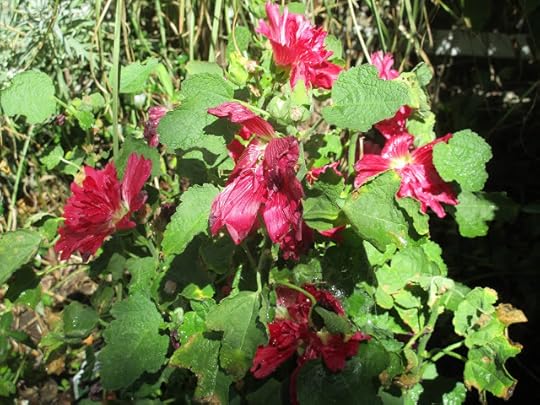 Some things are worth waiting for. When it comes to the products of the natural world, we always have to wait, whether the results are judged worthy or not. And in a season as dry as the summer that just concluded, we are going to wait a little longer.
Some things are worth waiting for. When it comes to the products of the natural world, we always have to wait, whether the results are judged worthy or not. And in a season as dry as the summer that just concluded, we are going to wait a little longer. 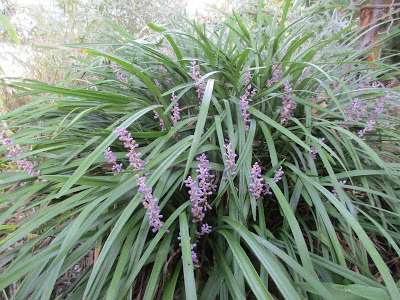 With this Hollyhock, at top, the waiting has just begun. I bought and planted it in August, so we'll have to wait until next year to see if the plant develops those long flower spikes the plant is known for. They are rumored to grow as high as nine feet tall, and varieties with red flowers are said to attract butterflies and even hummingbirds. And I have noticed some attention from the bees, who come to visit us, in considerable numbers, every day. Given this year's far from ideal conditions, I am glad the plant is still with us. The next plant down is a Liriope, a plant I've grown fond of because it blossoms in August, when not a lot of other perennials do. Here's a description from the Missouri Botanical Garden:
With this Hollyhock, at top, the waiting has just begun. I bought and planted it in August, so we'll have to wait until next year to see if the plant develops those long flower spikes the plant is known for. They are rumored to grow as high as nine feet tall, and varieties with red flowers are said to attract butterflies and even hummingbirds. And I have noticed some attention from the bees, who come to visit us, in considerable numbers, every day. Given this year's far from ideal conditions, I am glad the plant is still with us. The next plant down is a Liriope, a plant I've grown fond of because it blossoms in August, when not a lot of other perennials do. Here's a description from the Missouri Botanical Garden: 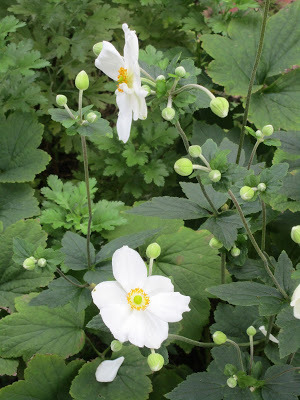 "Easily grown in average, medium, well-drained soils in full sun to part shade. Prefers moist, fertile soils in part shade. Tolerates wide range of light." It's that tolerance I'm particularly fond of. I've grown them in shady spots, and less shady spots, in both the side of the house and the back of the house gardens. They grow fuller every year, put up with competition from groundcovers like Vinca Minor and are not particularly aggressive. A second Liriope with white flowers is shown below.The next two photos are the late-blooming anemone plants. The anemone with a delicate light pink blossom started in late July this year and is no longer in flower. The dark pink blossoms (below, left), shown here have been my favorite September performer for several years. They're just peaking now. I don't remember the white-flower variety (above) blossoming so late in the past. I'll enjoy seeing it in October. I have two examples of asters too. One, with red flowers, grows much taller. The purple flowered plant grows thick and stays low. Asters are regarded as full sun plants, but they have grown and blossomed well for us in partial shade conditions. The bees, contending with a low-rain summer, which robbed some flowers of their usual supply of nectar, have declared themselves much enamored of these end of summer plant, particularly the red-flowering plant.
"Easily grown in average, medium, well-drained soils in full sun to part shade. Prefers moist, fertile soils in part shade. Tolerates wide range of light." It's that tolerance I'm particularly fond of. I've grown them in shady spots, and less shady spots, in both the side of the house and the back of the house gardens. They grow fuller every year, put up with competition from groundcovers like Vinca Minor and are not particularly aggressive. A second Liriope with white flowers is shown below.The next two photos are the late-blooming anemone plants. The anemone with a delicate light pink blossom started in late July this year and is no longer in flower. The dark pink blossoms (below, left), shown here have been my favorite September performer for several years. They're just peaking now. I don't remember the white-flower variety (above) blossoming so late in the past. I'll enjoy seeing it in October. I have two examples of asters too. One, with red flowers, grows much taller. The purple flowered plant grows thick and stays low. Asters are regarded as full sun plants, but they have grown and blossomed well for us in partial shade conditions. The bees, contending with a low-rain summer, which robbed some flowers of their usual supply of nectar, have declared themselves much enamored of these end of summer plant, particularly the red-flowering plant. 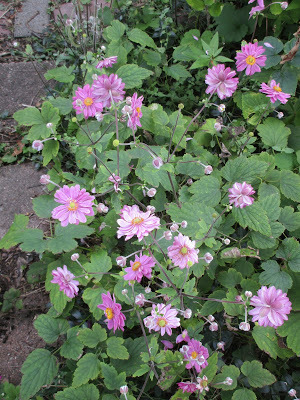
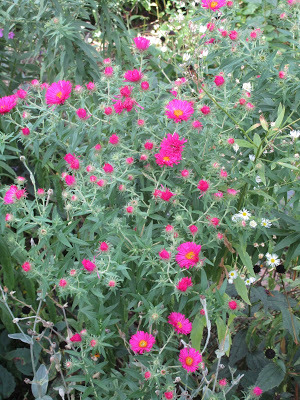 The final photo shows one of our knockout roses. A true ever-bloomer, this plant prefers late summer to May and June. It develops new buds through October, and in mild winters, we have still had roses in December.
The final photo shows one of our knockout roses. A true ever-bloomer, this plant prefers late summer to May and June. It develops new buds through October, and in mild winters, we have still had roses in December. 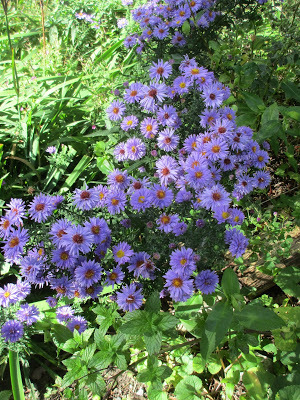
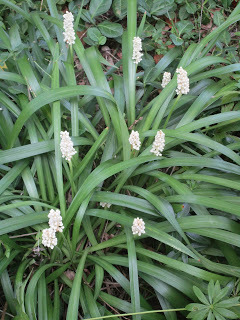
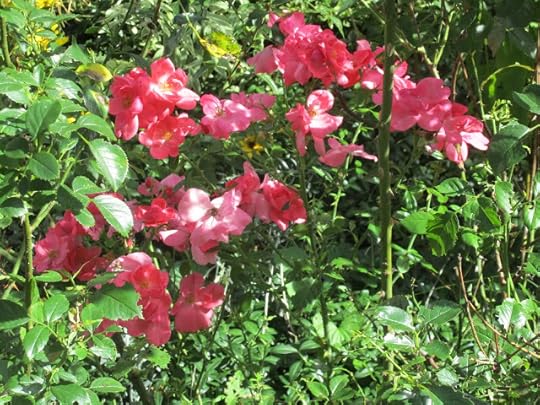
Published on September 28, 2016 20:43
September 25, 2016
September in the Garden: An 'Annuals' Affair
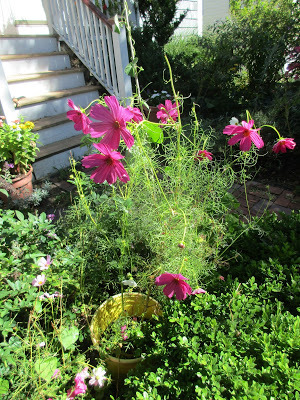
A recipe for September. Plant your annuals from seed. Let them take their time growing all summer, and keep watering them when they flower best at the end of the season.
In the top photo, at left, the cosmos I planted by seed in a seedbed out back sometime not too early in the summer are flourishing now. Somehow I never get around to starting seeds early. All the advice givers have you starting these seeds indoors, in a greenhouse, or a cold frame; soaking the seed in the water, or on paper towels, and otherwise acting as if the fate of the entire summer depends on your doing everything perfectly. Or, you can toss them into the ground when the soil has warmed up; forget about them; and then walk by some time in July and say, 'Oh, look, cosmos.'
I transplanted the cosmos to wherever I found space for them. Some spaces, naturally, worked better than others. In the photo at left, I potted them so I wouldn't have to disturb the soil below where perennials, bulbs in this case, are already waiting for next spring.
The plants in the second photo from the top, showing a collections of potted annuals, are a different story. These pots occupy a place where an old shed collapsed under our record snowfall two winters ago. We had the shed removed, opening up a flat corner of the yard that got morning sun. I covered the ground, a messy piece of dirt with very little topsoil, with crushed stone, raked it flat and planted it entirely in containers (left over from other purchases) with inexpensive annuals bought some time in June.
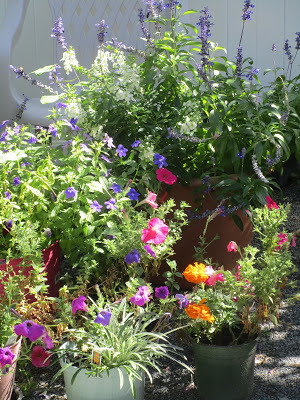
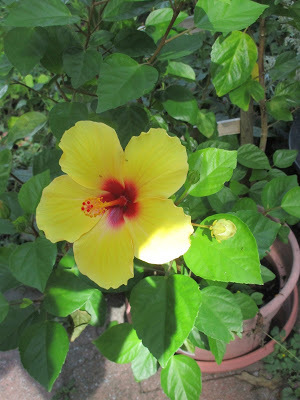
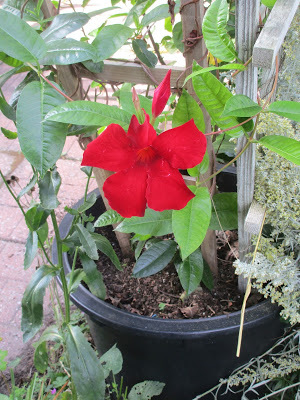
Prominent in this photo are petunias, blue salvia (a very rewarding sun plant), white-flowering Angelonia, some marigolds, verbena, the orange-flowering Gazania, and another purplish-blue plant called unhelpfully 'blue-bells.' Also Lantana (not visible here). I dug some surplus blacked-eyed susans and potted them as well; they flower in July and August, but are pretty much done now. The work here comes in watering them; nature didn't help very much in Massachusetts this summer.
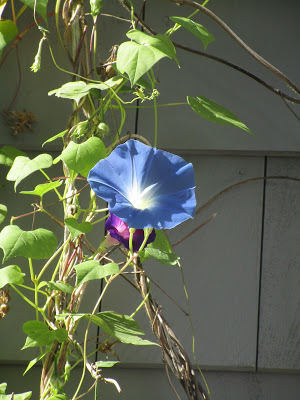 The third photo down is the yellow hibiscus. This color blossom is a great variety for this plant. This particular specimen spent the winter (not too happily) indoors and took pretty much until the end of August before blooming regularly.
The third photo down is the yellow hibiscus. This color blossom is a great variety for this plant. This particular specimen spent the winter (not too happily) indoors and took pretty much until the end of August before blooming regularly. The next plant down is the red-flowering Mandeville rose, another popular hibiscus that will bloom until the frost.
The next, the fifth photo down, is the morning glory, another sun-loving annual that I am planting behind the house in a place convenient for climbing but which does not get full sun. The blooms don't come until late summer.
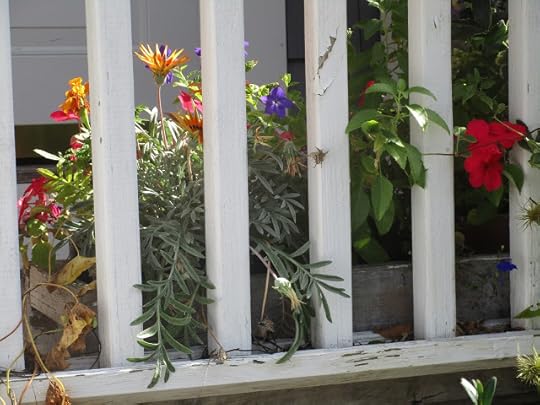 Finally, some of the same annuals as those seen earlier in pots. This time they are planted in Anne's densely populated flower boxes, supplemented by a happy gathering of red-flowering impatiens.
Finally, some of the same annuals as those seen earlier in pots. This time they are planted in Anne's densely populated flower boxes, supplemented by a happy gathering of red-flowering impatiens.
Published on September 25, 2016 21:49
September 21, 2016
Garden of the Musical Theater: 'Sunday in the Park' with Sondheim
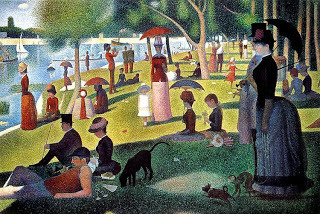 There is so much life in the essentially melancholy story line of Sondheim's musical "Sunday in the Park with George." Including, perhaps, a story of noble dedication and sacrifice. Or, perhaps, of the costs of such sacrifices.
There is so much life in the essentially melancholy story line of Sondheim's musical "Sunday in the Park with George." Including, perhaps, a story of noble dedication and sacrifice. Or, perhaps, of the costs of such sacrifices.Simply hearing a few phrases from "Maria" or "Some Day" can make you want to cry if you know "West Side Story." The theme from the Franco Zeffirelli film version of "Romeo and Juliet" produces a similar emotion in me. Musical moments from "Carousel" or and from the heart-break songs in "Les Miserables" have the same effect on those of us who love those shows. I don't have a simple word for the emotion produced by the recurring theme in "Sunday in the Park with George," with music and lyrics both by Stephen Sondheim, likely to prove one of enduring works for musical theater from recent decades. Last weekend we saw the current production by the Huntington Theatre Company. How do you create a musical about a painting? The painting by George Seurat (known to art history as a "pointillist") bears the original title "Un dimanche apres-midi a I'lle de la Grande Jatte." It depicts an "ordinary Sunday" in a Parisian "suburban park." Sunday was the single day off in the miserable Victorian work week of the latter 19th century, but the range of leisure time diversions by today's standards was not wide. So people go to the park, and once there they complain how hot it is. The painting stands out even in the incredibly prolific era of 19th century French art as a masterpiece. It is filled with people and also with impersonality. It offers a point of view on both the richness and the constraint of the life we urban dwellers live: an unremarkable moment in the inner life of a socially respectable people spent in a public space. This is my understanding, at least, of the point Sondheim is making in a quoted remark in the Huntington Theatre's program (written by Charles Haugland): "... you start speculating on why none of them are looking at each other..." Contemporary subway trains can be just like that. Every elevator ride as well. The painting is a big canvas. Seurat employed the technique, largely of his own invention, of creating figures and backgrounds out of tiny dabs of unmixed color. Beside a yellow dab, he places a yellow-orange one. The idea, Sondheim states, is to let the eye mix the colors. Sondheim's comments do not explain why he chose the painting as the theme, and setting, of his musical play. (I'm not sure such choices are explicable.) He credits the writer of the play's 'book' (storyline), Jim Lapine, with this 'key observation' on the painting: "Of course the main character's missing...The artist." Who is 'George' in this musical play? He's the creator who refuses to "engage," as we say today, with the scene that he is recording. He is polite, but always to the point. The point is how to stand or sit. To hold the neck up. To turn the head one way or another. The plot offered us in 'Sunday's' first act, the act that matters, is minimalist. In other works Sondheim has characters major and minor running around, hiding from each other, concealing stuff, revealing secrets at key moments. Here we have George, whose major song sums up the meaning of his life, his character this way: "I made a hat today." It's brilliant. He is his work. By telling himself to finish the hat -- all those little, perfectly executed dabs -- he has been true to himself, but not to his lover, his model, whom he has failed to take to the Follies that evening. "We will go to the Follies tonight," he tells her in a rare personal comment. But they don't. Theirs is the sort of affair in which one person does all the talking, and wonders alound what the other person is thinking. Does he care? George is a person whom others talk to, and some seek to define, but who resists all attempts to define him by the simple expedient of addressing only the needs of his art. His lover is having his child, but the artist doesn't claim the child -- or her. He allows her to marry a baker instead. Sondheim explains the ways his musical composition mirrors Seurat's pointillist technique of using pure colors and letting the eyes mix colors close to one another on the color wheel. The composer takes a similar approach by alternating major and minor keys: "If you listen to the alternation ... the alternation between a major third and minor third, if you justapose them, is exactly like juxtaposing yellow with yellow-orange or red with red-orange. " It's a way to evoke emotion in the listener, Sondheim says. "The ear blends them," he states. "That little major/minor alternation... the ear blends those two things and it comes to this unsettled, but very poignant chord." Poignant it is. I can't think of any better word to describe the way the music affects you, and stays with you. And of course, it also works because he matches the lyrics so perfectly to the emotional space created by those alternations. The result is deeply, enduringly melancholy -- a word that includes beauty in its cluster of shaded meanings. I can't say much for the second act of the show, which jumps a century ahead to our own time and is said by Sondheim to mirror the structure of the first half, both musically and narratively. This may be so, but compared to the first act, the second feels forced and cliched. The narrative is predictable and the characters trite. And there's no George, no model-mistress, no painting, and the park is nothing like what it once was. Even without these narrative strengths, the music remains as affecting as it is in the play's brilliant first half. By the end all I'm doing is listening to those "little" alternations. They're all I know, and all I need to know. The Huntington Theater Company production continues through Oct. 16. Here's the link to the theater's site: www.huntingtontheatre.org
Published on September 21, 2016 09:28
September 19, 2016
The Garden of Verse: On the Menu Today... Food
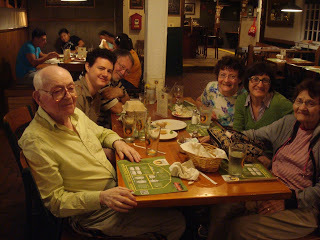 Food is almost too easy a subject. Everybody has something to say about food. Some people never stop talking about it. Sometimes we realize we've become those people ourselves. 'And the food? You can't believe the food.' It's our definition of a good time. What do we do to have fun? Let's have a party. What's the secret of a good party? Experts say it's the food. What will we do when the guests come to visit? Let's go out to eat! Anybody know a good restaurant? So the optional theme of the September issue of Verse-Virtual, the online poetry journal to which I contribute each month, is food. Alas, I have already written about this rich and universal theme in a poem called "Invitation to the Feast," published on Verse-Virtual a year ago. On closer inspection, the poem which begins this way...
Food is almost too easy a subject. Everybody has something to say about food. Some people never stop talking about it. Sometimes we realize we've become those people ourselves. 'And the food? You can't believe the food.' It's our definition of a good time. What do we do to have fun? Let's have a party. What's the secret of a good party? Experts say it's the food. What will we do when the guests come to visit? Let's go out to eat! Anybody know a good restaurant? So the optional theme of the September issue of Verse-Virtual, the online poetry journal to which I contribute each month, is food. Alas, I have already written about this rich and universal theme in a poem called "Invitation to the Feast," published on Verse-Virtual a year ago. On closer inspection, the poem which begins this way... I'd like to start with some Inspiration Soup. A small bowl if it's strong enough.
I'm leaning to Puccini, and if you have something off of "La Fanciulla del West," I'd be in emotional-culinary heaven. (Add a dash of emoticon if you're of a mind to.)
... is not really about 'food' -- the various sources of nutrition -- but about the rituals. So once again when the 'food theme' crossed my mind, it was not what we eat, but the act of eating, the role of eating, that stirred my appetite for words. More central than what we eat, the act of eating is the central activity, and ritual, of a successful, long-lasting life. It keeps us going in more ways than we easily enumerate. Do not mistake me, we are fascinated by what we eat. Probably always have been. But it's the "let's eat" button pushed continually by our brain that triggers the whole human behavioral repertoire. Our eyes open: a new day. Even if nothing else summons us -- no job to do; no responsibilities -- we might lie around in bed for what, an hour or two?, before the idea of breakfast gets us out of bed.
Eating eats at us. But what happens if you have no appetite? This condition has appeared only a few times in my fortunate span of years. The only times that endure in memory are directly following surgery, probably the only extended periods when I have had to force my body to learn how to eat. When the whole idea of consumption was not only unappetizing, but positively repugnant. A life turned upside down. Eating is not only the activity that keep us going physically, it's the activity that tell us who we are. Who am I without it? Anywhere here's the poem that confronts that fraught circumstance:
Appetite Post-Surgical
My food is eating me
When I lie down my stomach sits up,
this sick center of mortal existence
Which of us will digest the other?
Indigestible me:
a pain additive
choked down with every feeding
grows at length into a bigger pain
until it alienates my affections
from the act of consumption,
then goes on to sitting, standing, reclining,
working up to breathing,
even as we cease to speak
Food and I are at an impasse,
a no-go zone
I lounge in my bed sheets,
recalling a lustier fellow at table,
eating everything in sight
'These skinny guys,' a portlier colleague once remarked,
with some ire,
'who can eat so much pizza'
Pizza free, he's hiding in there somewhere,
that long-ago lithe fellow reliably good for dessert,
desperately seeking to eat his way out
Another poem in the September Verse-Virtual also plays fast and loose with the way we think about eating. It's called "Food for Thought." The opposite of my "no appetite" poem, this one is about the drive we sometimes feel to 'consume' experience. How was the show? 'We ate it up! We loved it!' We danced in the aisles (literally, or figuratively). But not only do we want to eat up the world, sometimes there are things -- forces -- that want to eat us. In this state of hominid development, we're not particularly worried about lions and tigers, as we once were when we were little tree-habituated creatures trying to last out a winter in a cave. Runaway appetites is the theme for this loosely-strung effort titled "Food for Thought." As the title suggests, the metaphorical expansion of the notions of food and eating is, as the expression goes, as big as life. Here's an exerpt:
...A monster is loose, seeking to eat us all,
as we scurry down the alley-way of tomorrow,
today already consumed (used up; no good any more)
The glass and steel towers zoop us up,
giant anteaters with air-conditioned intestines,
butts litter the sidewalk
We will eat this day through a mound of doughnuts
taller than the Imperial Nation Building,
consuming the century that is no longer ours...
You can read the rest, and all the other poems this month, at http://www.verse-virtual.com/robert-k...
Published on September 19, 2016 09:05
September 14, 2016
The Garden of the Birds: Great Moments for Great Egrets
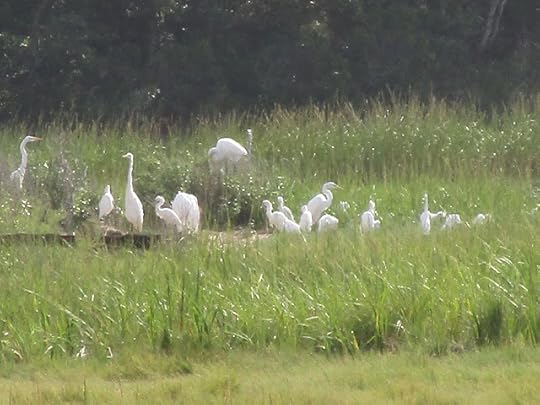
The Great Egret is a big and striking bird. We see them in Quincy, in coastal marshes and along the estuarial Furnace Brook quite often. But I am often surprised when others walk by without even turning a head in their direction. Since we don't try to kill these birds for food, and I'm happy we don't, and since we don't kill them any more for their beautiful white plumage to ornament our hats -- a really good idea to put an end to that -- the bird population has recovered to the point where I know I'm going to see some every year.
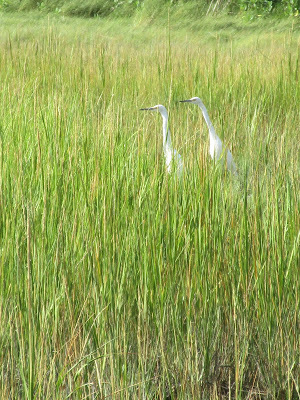 Still I'm surprised that large, dominant two-legged animals can be so blase about seeing them. They just don't see the point of looking at these amazing living creatures, which makes me sad. When they walk or ride past a heron-sized wading bird standing stock-still in a shallow stream, long serpentine neck pulled in tight, or fully extended just above the water surface like the prow of some ancient fishing vessel, what do they think they're seeing? An albino seagull? Don't take my word for this splash of wonder in a largely urban landscape. Here's the description provided by the Cornell Orinthology lab: "The elegant Great Egret is a dazzling sight in many a North American wetland. Slightly smaller and more svelte than a Great Blue Heron, these are still large birds with impressive wingspans. They hunt in classic heron fashion, standing immobile or wading through wetlands to capture fish with a deadly jab of their yellow bill." Serious hunters, they are elegant fliers as well. With those long wings they don't need to flap around a lot to stay aloft. They thrust hard with those tripartite wings to get off the ground, but they're able to use the slightest updraft or current to glide. Smaller birds work harder to get aloft where the drafts are stronger. Heron-family birds float off as if the sky itself were a magnet.
Still I'm surprised that large, dominant two-legged animals can be so blase about seeing them. They just don't see the point of looking at these amazing living creatures, which makes me sad. When they walk or ride past a heron-sized wading bird standing stock-still in a shallow stream, long serpentine neck pulled in tight, or fully extended just above the water surface like the prow of some ancient fishing vessel, what do they think they're seeing? An albino seagull? Don't take my word for this splash of wonder in a largely urban landscape. Here's the description provided by the Cornell Orinthology lab: "The elegant Great Egret is a dazzling sight in many a North American wetland. Slightly smaller and more svelte than a Great Blue Heron, these are still large birds with impressive wingspans. They hunt in classic heron fashion, standing immobile or wading through wetlands to capture fish with a deadly jab of their yellow bill." Serious hunters, they are elegant fliers as well. With those long wings they don't need to flap around a lot to stay aloft. They thrust hard with those tripartite wings to get off the ground, but they're able to use the slightest updraft or current to glide. Smaller birds work harder to get aloft where the drafts are stronger. Heron-family birds float off as if the sky itself were a magnet.
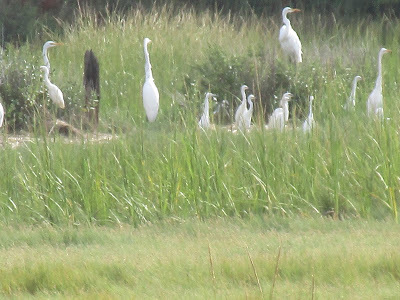 Some years they're more plentiful in Quincy's marshes and shorelines than others. Generally I see a few on the broad salt marsh neighboring Wollaston Beach. The harbor waters flow underneath busy Shoreline Drive and fill the channels of the marsh as the tide comes in, draining them as the tide goes out. The egrets need water shallow enough to wade in, standing motionless on those stick legs to wait for prey. But deep enough so the tiny sea creatures they feed on will be moving up stream or down.
Some years they're more plentiful in Quincy's marshes and shorelines than others. Generally I see a few on the broad salt marsh neighboring Wollaston Beach. The harbor waters flow underneath busy Shoreline Drive and fill the channels of the marsh as the tide comes in, draining them as the tide goes out. The egrets need water shallow enough to wade in, standing motionless on those stick legs to wait for prey. But deep enough so the tiny sea creatures they feed on will be moving up stream or down.
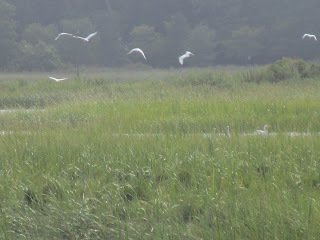 A decade ago, when we fist moved into this part of Quincy close to Wollaston Beach, I occasionally came upon broods of egrets in my walks on the marsh path. I'm told they nest in trees, and no trees are available in the marsh. But judging from their size, most of the birds I saw were first-year waders; yearlings. They clung together, close to their elder out in the thick salt grass (Spartina patens) patches far from the dry footpaths, far beyond where the human beings of our era are likely to pursue. We don't stomp through muddy-channeled marshes even at lowest tide to get our hands on wading birds. I'll bet our ancestors did; probably hunted their eggs too. Those extended family groups stopped taking breaks in the Wollaston marsh, at least on the days I made my scouting expeditions. I began taking photos of egrets and other birds I did see; three or four egrets at once would be high-density days. This year, for whatever reason, I've found egrets in larger numbers on a couple of occasions again. Last week as I rounded the point in my usual marsh-trail progress, I saw the first few birds, lifting their wings and gliding from point A to point B among the flattened grasses. Standing a few feet in front of me an even rare site: a couple of fellow human explorers. I can go a whole year of visits on this path without encountering anybody else on it, so this was a remarkable day. The woman of the pair asked me if I had been on this path before; presumably they hadn't. "Oh, yes." She started to speak, but I interrupted. "Look, egrets!" They looked, I think. But no response. "They're very big birds. They're waders. They migrate here from the South." Kind of nothing to say. I don't know, maybe it was my civic duty to share anything more I knew of this subject with the newbies and worker harder to stimulate interest, but I wasn't getting a lot back. I wished them a good day and kept going around the point, and my view opened on the first dense -- 'flock' doesn't seem right; encampment is more like it -- of Great Egrets taking a migration break in our salt marsh. Wow. Lots of egrets. Out comes the camera. I've worried that my avidity for taking their picture has discouraged large bird presence from our marsh. They'd rather not be the objects of my attention. They'll remember my intrusion and choose another marsh next time. So I try not to take too many photos of the same bird, or group. But this was ridiculous. I looked back at the couple of first-time visitors, but I couldn't tell if the bird show had attracted their attention. Then I saw the strangest thing I've ever seen in this place. A diminutive man (man's clothing at least) emerged from somewhere, walked determinedly past me, perhaps not noticing me, wearing a cloth hat and cape-like smock and carrying a camera; strode right into the marsh (where I was sure no two-legs would ever venture); and headed toward the Egret camp-in. Recovering from my surprise, I walked along my path to get a better view of his intentions, and opened a panorama on a second large multi-generational grouping of egrets. I've seen more big birds in one place before. But that place was Florida. We're lucky to have egrets and herons and hawks up here. They're summer people. We're fortunate to still possess the habitats that attract them for breeding season. Little coastal wildernesses. Micro-habitats that we somehow haven't polluted, drained, or otherwise over-used in our dense domination of the planet beyond their value for other lifeforms. I looked back at the first group of birds and spotted the little man in earth-toned clothes setting up a tripod, shielded by some tall grass (Spartina alterniflora) presumably to take some shots of the egrets at rest or play or work in our marsh.
A decade ago, when we fist moved into this part of Quincy close to Wollaston Beach, I occasionally came upon broods of egrets in my walks on the marsh path. I'm told they nest in trees, and no trees are available in the marsh. But judging from their size, most of the birds I saw were first-year waders; yearlings. They clung together, close to their elder out in the thick salt grass (Spartina patens) patches far from the dry footpaths, far beyond where the human beings of our era are likely to pursue. We don't stomp through muddy-channeled marshes even at lowest tide to get our hands on wading birds. I'll bet our ancestors did; probably hunted their eggs too. Those extended family groups stopped taking breaks in the Wollaston marsh, at least on the days I made my scouting expeditions. I began taking photos of egrets and other birds I did see; three or four egrets at once would be high-density days. This year, for whatever reason, I've found egrets in larger numbers on a couple of occasions again. Last week as I rounded the point in my usual marsh-trail progress, I saw the first few birds, lifting their wings and gliding from point A to point B among the flattened grasses. Standing a few feet in front of me an even rare site: a couple of fellow human explorers. I can go a whole year of visits on this path without encountering anybody else on it, so this was a remarkable day. The woman of the pair asked me if I had been on this path before; presumably they hadn't. "Oh, yes." She started to speak, but I interrupted. "Look, egrets!" They looked, I think. But no response. "They're very big birds. They're waders. They migrate here from the South." Kind of nothing to say. I don't know, maybe it was my civic duty to share anything more I knew of this subject with the newbies and worker harder to stimulate interest, but I wasn't getting a lot back. I wished them a good day and kept going around the point, and my view opened on the first dense -- 'flock' doesn't seem right; encampment is more like it -- of Great Egrets taking a migration break in our salt marsh. Wow. Lots of egrets. Out comes the camera. I've worried that my avidity for taking their picture has discouraged large bird presence from our marsh. They'd rather not be the objects of my attention. They'll remember my intrusion and choose another marsh next time. So I try not to take too many photos of the same bird, or group. But this was ridiculous. I looked back at the couple of first-time visitors, but I couldn't tell if the bird show had attracted their attention. Then I saw the strangest thing I've ever seen in this place. A diminutive man (man's clothing at least) emerged from somewhere, walked determinedly past me, perhaps not noticing me, wearing a cloth hat and cape-like smock and carrying a camera; strode right into the marsh (where I was sure no two-legs would ever venture); and headed toward the Egret camp-in. Recovering from my surprise, I walked along my path to get a better view of his intentions, and opened a panorama on a second large multi-generational grouping of egrets. I've seen more big birds in one place before. But that place was Florida. We're lucky to have egrets and herons and hawks up here. They're summer people. We're fortunate to still possess the habitats that attract them for breeding season. Little coastal wildernesses. Micro-habitats that we somehow haven't polluted, drained, or otherwise over-used in our dense domination of the planet beyond their value for other lifeforms. I looked back at the first group of birds and spotted the little man in earth-toned clothes setting up a tripod, shielded by some tall grass (Spartina alterniflora) presumably to take some shots of the egrets at rest or play or work in our marsh.
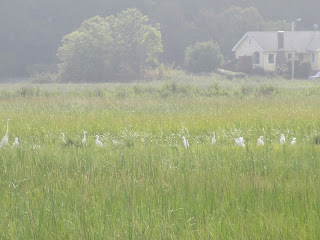 So this is who we are. Some of us will march straight into the mud to get a good photo. Others, by far the majority, won't even know there's anything worth seeing. People, this is your planet. It's all the other species's planet as well. Get to know your neighbors.
So this is who we are. Some of us will march straight into the mud to get a good photo. Others, by far the majority, won't even know there's anything worth seeing. People, this is your planet. It's all the other species's planet as well. Get to know your neighbors.
Published on September 14, 2016 21:13
September 13, 2016
The Garden of Verse: A September Harvest Home
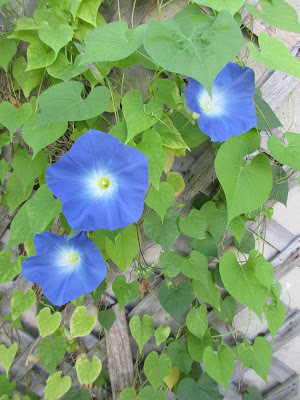
Among the nursery rhymes most of us are familiar with, there's a special kick in recalling the Muffin Man who lives on Drury Lane. Maybe, as Dick Allen says in his poem "Do You Know the Muffin Man?": There’s a sort of Zen to him,
like loss rerouted to gain,
Among the varieties of the Muffin Man's wares the poem cites, I'm particularly enamored of
The ultimate muffins, the muffins
to die for, the muffins of fame,
and the muffins of Meaning, the muffins
none can explain,
In an issue with an optional food theme, I'm glad September's Verse-Virtual remembers the gifts of the Muffin Man. Elevenses, anyone?
Joyce Brown offers two perfectly wise poems in the September issue. In "Food Supply," she offers us the advantages of a goat-like approach to food.
In a perfect world,
we would eat like goats,
anything at hand —
soap, soup cans, weeds.
She cinches the case for me by adding to the goat's diet yesterday’s New York Times.
I so wish I could see the Sunday papers instead of rounding them up for recycling. Equally good advice can be found in "Rackets." Your opponent hits the ball with force.
Relax your grip a bit, take off some pace.
Control, not power, is the smarter course.
I'll try to remember that next time I find myself in a political disagreement. I've never played tennis, but the advice derived there from the game makes so much sense for the back-and-forth of life. The poem's flexible rhyming scheme appears to illustrate its meaning. Not all of the poem's rhymes land hard. Some land soft, and some land near.
....Soft hands!
When life comes at you hard,
prepare to move and change your plans.
Plenty of wisdom as well in David Chorlton's series, "Poems from the Rainforest." Especially in "After the Rainforest," when the landscape invites us to see the oneness in inter-dependent life.
Whatever is here keeps changing: insects
turn into leaves; the leaves
become ants; the ants turn into red mounds
that burn into the ground, and the rain
that falls on everything
turns into trees.
In this "extreme drought" summer, the rain in our little backyard forest came from the mouth of the hose or the sprinkler, but the plants I helped keep alive kept me cool, offering shade and taking the greenhouse gasses out of the atmosphere. And I was particularly cheered by these words from the poet on the gain won by encountering the rainforest: [you] return to your other worldwith the ancient strength of animalsin your every step.
Wisdom in encountering the wild is a theme in Sylvia Cavanaugh's poem "Harvest." Describing autumn in "a patch of neglected wood" -- a landscape I'm drawn to myself -- the poem suggests the natural religion of outdoor spaces.
A type of folk Mass
unfolds in this sun dappled cathedral, the
absorption of one body into another, the face
of the orb cheerful, even after the sudden drop down
to earth.
From there the poem picks up its opening image of an old apple tree, works it through Eve's choice and leaves us with an evocation of the search for windfall fruit amid "a loam tasting of lost apple." A marvelously unified poem.
There's wisdom and meaning in the autumn ritual of orchard apple-picking as well, as Firestone Feinberg's homage to this family activity tells us: "Every apples takes you home."
These poems and more can be found at http://www.verse-virtual.com/poems-an...
Published on September 13, 2016 21:56



